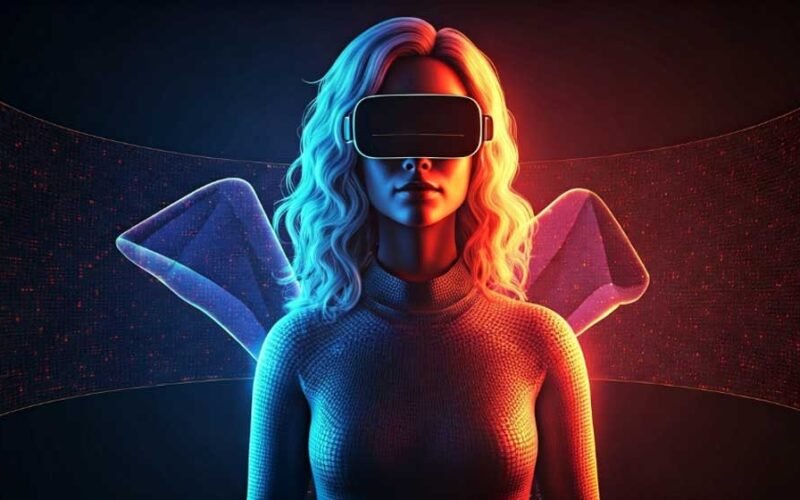Key Highlights
- Living NFTs in VR games dynamically evolve in appearance, skills, and ownership traits, offering deeply immersive experiences.
- Game engines like Unity and Unreal Engine form the backbone for integrating mutable NFT attributes in virtual reality environments.
- VR platforms such as PlayStation VR, Oculus, and Steam support innovative use cases for living NFTs, enhancing player engagement.
- Smart contracts and game scripts drive NFT mutability within the VR game ecosystem, linking progression and personalization.
- Overcoming challenges like motion sickness and asset security is crucial for game developers aiming for optimal user experience in VR.
- Future trends point toward AI-driven evolution and adaptive gameplay, shaping the next generation of virtual reality gaming.
Let’s begin by exploring how living NFTs and VR gaming are transforming immersive experiences.
Introduction
Immersive experiences are changing the way people play and connect in virtual environments. These new ways of playing have started a wave of change in development of VR games. When living NFTs are added to this mix, they help keep players more interested. They also bring in parts that act more like real life. When the best technology is used along with smart game design, vr games can offer more layers and new things to discover as time goes on. Players will also be able to shape the gaming world and change assets themselves. This is turning around what virtual reality gaming used to be like. Because of all this, the future of virtual reality gaming looks fun and full of new ideas.
Understanding Living NFTs in VR Worlds
Living NFTs in virtual reality worlds are changing how gaming works. These smart items can change and grow when players interact with them. This makes the user experience better and helps games feel more real. Programmers and game designers work hard to add ways these NFTs can show different traits. This leads to new and interactive stories in games.
This new idea makes virtual reality games look better. It also starts a new way for people to own things and move forward in games. Gamers now get to join in and be part of special digital worlds that are not like any other.
What Makes an NFT “Living” and Dynamic?
A “living” NFT is something that can change and grow as time goes on. The things people do and the choices they make in the VR space will affect how the NFT looks or acts. This means its features can be changed by what you do when you play. So, every NFT stays new, fun, and different for each person using it in vr.
Core Principles Behind Mutable NFT Attributes
Mutable NFT attributes change based on what happens inside virtual reality worlds. They grow or shift when players make choices. This is possible because there are computer rules that respond to what players do. It makes people feel like they own and care about these items. How these NFTs work depends on things like being able to adjust, seeing what is around them, and giving players quick feedback. All of this helps these NFTs fit perfectly into the game and virtual reality setting. These ideas show how important it is to let people be creative and feel close to the items. Instead of being stuck and unmoving, these items can now become bright, interesting parts of the virtual world.
The Evolution of NFTs in Gaming and VR
There has been a major shift in the world of gaming. NFTs are no longer just static collectibles ,in many VR platforms, they have evolved into dynamic, interactive assets that players can customize, upgrade, and use in new ways. This transformation makes virtual reality gaming more exciting and immersive, allowing gamers to make unique choices and shape their own experiences.
When game developers integrate NFT game development into VR worlds, they create “living NFTs” that can be altered, traded, or evolved in real time. Players can instantly interact with and modify these assets, which adds depth to gameplay, strengthens storytelling, and opens new possibilities for player-driven narratives.
The combination of advanced technology, creative design, and NFT innovation is rapidly expanding in VR gaming. As accessibility to virtual reality grows, more users can explore these interactive worlds, experience richer gameplay, and discover just how much NFT-powered games have to offer.
From Static Collectibles to Interactive Assets
The move from still collectibles to things you can use and change in games has changed virtual reality gaming in a big way. Now, people can play in these immersive experiences and actually use their NFTs. This makes the user experience better and goes further than just having the items. When game developers add dynamic features, the items in the game can change and grow as players use them. This helps gamers feel even more connected to their virtual things. To do this, developers need to use smart game design, like adding AI and changing how the game works as you play. This helps to make a lively world where people can use NFTs in vr gaming.
Use Cases of Living NFTs Across VR Platforms
Living NFTs are changing the way people use virtual reality. On different VR platforms, these NFTs have many unique uses. Gamers can grow NFTs that change as they play, which helps them care more about the game and be more involved. In VR fitness, living NFTs work like a personal trainer. They change the workout plan by looking at how well you do. Also, in social VR spaces, these NFTs react to what users do, which helps people bond even more. These new ideas show how NFTs that change can help make virtual reality experiences better and get people even more involved in vr.
Key Components: Appearance, Skills, and Ownership
Living NFTs in VR are special because they change as you play. What you do in the game can make your NFT look different, so your journey shows on it. These NFTs also let you build new skills in the vr experience, and you can make them better as you play more. Also, you can really feel that you own these assets in the game. The way appearance, skills, and ownership work together makes the vr experience more real and lively. It turns what you do in VR into something that feels exciting and true.
How NFT Appearances Evolve with Player Choices
In the world of virtual reality, NFT appearances can change as players interact and make choices. The game lets people change not just how things look, but also what the items can do. By using software development tools and engines, the makers can build systems where every choice changes how the NFT is seen and used. This way of making the game helps improve user experience. It also makes each player’s time in the virtual world different and more personal.
Skill Progression Systems Linked to NFTs
Merging skill levels with NFTs brings a new layer to growth in virtual reality gaming. In VR, when gamers play with living NFTs, these items change and grow based on what players do and achieve in the game. This changing bond makes the VR experience feel real, and people get a true link to what they own in the game. Because of this, growing your skills does not just help you play better. It can also be good for the whole game’s trading and rewards system. It makes the journey in these virtual reality worlds, built by game developers, much more interesting and fun for everyone in gaming.
Dynamic Ownership Traits and Their Impact
Ownership in virtual reality is not like what we see in the real world. It can change all the time and shapes how gamers play the game. When people get and trade living NFTs, each one brings its own special things to the game. This can change how someone plays, and it lets people feel like they are part of what is going on. The way gamers own things in virtual reality can make the game feel more fun for everyone.
Gamers can pick and change their things in the game however they like. They do this by looking at what they want and how they act in the game. As a result, every move and every trade a gamer makes can change how the story goes. Plus, it helps the game and its economy grow. Every time someone buys, sells, or changes something with these living NFTs, the world inside the virtual reality game gets richer for all players and the community keeps changing and growing.
Toolkits & Engines for Developing Living NFTs in VR
There are several strong engines that help create living NFTs in virtual reality. Unity and Unreal Engine are the most popular ones. They each have special features that work for different needs. Unity is known for being user-friendly. This makes it a good pick for beginners in vr development. On the other hand, Unreal Engine is great for its advanced graphics. Many experienced people choose it for high-quality visuals.
Both engines support important software development kits and tools. This lets you work with blockchain tech without trouble. These are the building blocks for good vr gaming experiences. You can use both Unity and Unreal Engine to start your journey in virtual reality and software development.
Comparing Unity vs Unreal Engine for NFT Integration
Unity and Unreal Engine are both top choices for game developers who want to add NFTs to VR environments. Unity is a good option for beginners because it has a user-friendly interface. It also offers great support through its software development kits, and its asset store is large. This makes it good for people who are new to this area.
On the other hand, Unreal Engine is known for making high-quality, realistic graphics. This helps make immersive experiences even better, especially with dynamic NFTs. Both engines can be used with many different VR headsets. This lets developers choose what fits best for their project goals and the user experience they want to create. Both Unity and Unreal Engine help developers get the most out of vr, headsets, and new NFT features.
Essential SDKs, APIs, and Blockchain Tools
Using the right tools is important for good virtual reality game development. Software Development Kits, like Unity and Unreal Engine, help people make new VR worlds. APIs add features so you can use blockchain in the game, which makes things like NFTs possible. By looking at platforms like Ethereum or Flow, you get what you need for checking assets and moving them between people. When you use these tools along with version control, it helps the team work better together and bring in new ideas for VR apps and games. To stay on top in virtual reality game making, you have to keep up with the newest tools and updates.
Step-by-Step Guide: Designing a Simple Living NFT for VR
Creating a living NFT for VR takes a few new steps that make it more fun and real for the user. You first need to come up with the way it grows and acts. This has to match what the player does in the virtual world. After that, you get into coding the changes it can have. Use smart contracts along with scripts in a game engine, like Unreal Engine or Unity. After coding, test the NFT in different VR settings. This helps you check how well it works and to make sure gamers have a good time.
Conceptualizing NFT Growth and Behavior Mechanisms
Bringing dynamic growth and behavior to NFTs means looking at how players and their actions can shape digital items. By using systems that change and adjust, NFTs can grow and change based on what users do, what they like, and the choices they make. This helps make the world of virtual reality more fun and interesting. You could see things like changes in looks, abilities, or even who owns the items, all to match how each gamer plays. Developers use game engines like Unreal Engine and Unity for these features. This way, the gameplay blends well with tools players use, and the world reacts to how people play and use strategies.
Coding Mutability: Smart Contracts & Game Scripts
Making living NFTs that can change depends on strong smart contracts and flexible game scripts. These coding parts help add features where NFTs can change as people play. Smart contracts help make sure that any changes in who owns the NFT or what it can do are fair and safe, which is very important in the virtual reality world. Game scripts work in real-time to let the player’s choices shape and change the NFT as they play, making the gaming experience better and more exciting for everyone.
Overcoming Common Challenges in Living NFT Implementation
Navigating living NFTs in virtual reality gives new challenges for vr developers. It is important to keep the user experience smooth, so players stay interested in the game. When you add these features, you need to make sure loading times are short. Doing this can help lower motion sickness. Good performance makes the game more fun for vr gamers and helps people get into the game faster.
Security also matters a lot in vr. Making sure the digital items are real and safe needs strong blockchain rules. This gives the player trust in their virtual reality assets. These steps make it safer for gamers to have and use these items in the game.
Testing the game often and using clear performance checks can help vr developers solve many of these problems. By doing this, they create virtual reality experiences that people want. It also lets people trust their in-game items, which is good for players and the vr world.
Ensuring Performance and Player Immersion
Getting smooth performance in a virtual reality game is very important for keeping gamers inside the world of the game. You need to work on the graphics and how things move to make sure the hardware, like headsets such as Oculus Rift or HTC Vive, does not ruin the user experience. It helps to set clear frame rate goals and to design things in a way that cuts down on motion sickness. This is needed so that people can play the game for a long time without feeling unwell. It is also smart to use performance tools and do a lot of tests. This way, you can fix any problems and make all game actions feel real and smooth. Developers doing this work build good, immersive experiences that make both new and old gamers want to come back and spend more time in these virtual reality spaces, where the story and even things like living NFTs keep changing.
Addressing Security and Asset Authenticity
Making sure that a system is safe and assets are real is very important when it comes to living NFTs. The developers need to use blockchain technology. This helps everyone see who owns what, so there is no room for cheating or scams. The use of secure wallets by people can keep their digital things safe and stops others from taking them. With smart contracts, designers can set up records that nobody can change, and this helps build trust between people who use the system. It is also vital to check systems often and keep things up-to-date to make sure security stays strong. This way, gamers can get into their virtual reality experiences with no worries about losing their items or anything going wrong with their things in the game.
Best Practices for Balancing Gameplay and NFT Economics
Finding a good balance between fun gameplay and NFT use is important for keeping people in virtual reality games. Using flexible pricing that looks at what players do helps avoid pay-to-win, so everyone has a fair shot. Updating game features and NFT details often makes players want to keep coming back. When you tell everyone clearly about changes in the game’s money system, you help build trust. Also, bringing in user feedback when working on game design makes the NFT system and user experience better, helping the whole vr community grow.
Preventing Pay-to-Win Pitfalls in VR Environments
Making things fair in virtual reality is key if you want to keep gamers interested. When you set up balanced rules and systems, it makes sure that people who play with skill have the same chance as those who spend money. Using systems where people move forward based on skill, developers can build an environment where what you do and the way you play matter more than how much you spend. If you are open about prices and tell people how game assets work, it can help stop people from getting upset. Focusing on rewarding hard work gives players a better user experience. It also keeps the game honest and helps build a strong and active player group in virtual reality experiences.
Creating Fair Progression and Accessibility
Making sure that everyone has a fair chance to move forward and enjoy virtual reality is very important if you want to keep players interested. Good game design in virtual reality should have systems that help all players, no matter how skilled they are, take part and have fun. This means using features that help people build their skills step by step. It also means not using pay-to-win tricks, because those are likely to push away casual gamers.
If developers focus on making sure everyone can get to game items and experiences easily—by using smart code and dynamic NFTs—they can boost user experience in VR. This helps people across different VR platforms. In the end, if everyone is welcome, the VR gaming world can grow and have a strong community of excited gamers.
Future Trends: Where Are Living NFTs in VR Headed?
As living NFTs keep changing, more games will start using AI. This will help make each game more personal and fun for players. You will find new ways to play, which will make the stories and feelings in vr and gaming even stronger. Because of ai, people can get more involved in these virtual worlds, and this could change how we all play and enjoy vr and gaming.
AI-Driven Evolution and Adaptive Gameplay
Using artificial intelligence (AI) in VR gaming makes the way you play more exciting and fun. With machine learning, game makers can build better worlds in the game. The game can change, react, and even learn from what you do in it. This helps give you a fresh user experience every time you play. Stories and challenges in vr gaming can also be different for each gamer. When AI looks at how you play, things like living NFTs can change as you play. This means it’s always something new when you come back. Focusing on an AI-driven design in vr makes the worlds more real and keeps gamers interested. It brings new ways for us to be a part of the game and lets every session stay full of surprises.
Conclusion
The future of living NFTs in VR looks bright. There are many new ways for gamers to connect with the world of virtual reality. As technology gets better, these gaming experiences will bring more player engagement and offer more personal ways to interact. By adding AI-driven tools, the boost in these NFTs will change how gameplay works. It will also make the user experience in a vr game smoother and better. This new level of design sets the bar higher for vr game and virtual reality gaming. It also gives both creators and players more ideas and freedom to try new things in gaming. The growth of vr and ai together will shape better and more immersive experiences for everyone in the world of game design.
Frequently Asked Questions
Do I need coding experience to create living NFTs in VR?
While it can be good to have some coding experience for making living NFTs in vr, you do not always need it. There are many tools and engines with interfaces that are easy to understand. These also have simple ways to use visual scripting. So, even if you do not have a lot of programming skills, you still can design and put in dynamic NFT features in a good way.
What hardware should I use to develop and test VR NFTs?
For making and testing VR NFTs, go for a fast machine that has a strong graphics card. Try to use one from the NVIDIA RTX series. Also, use a VR headset like the Oculus Quest or HTC Vive. This setup gives you good speed and power. It helps you have better and more immersive experiences when you make and try out NFTs in a virtual world.
Are there any beginner-friendly courses for making dynamic NFTs in VR?
Yes, there are a few platforms that have courses for people who want to start with making dynamic NFTs in VR. Some websites like Udemy and Coursera, along with different education sites that focus on blockchain, offer lessons that can help you learn about NFT design, smart contracts, and how to use VR with them. These courses are made for people who are new to this area.










